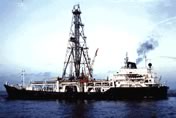Glomar Challenger: Drillship of the Deep Sea Drilling
Project

It was on June 24, 1966, that the Prime Contract between the National
Science Foundation and The Regents, University of California was signed.
This contract began Phase I of the Deep Sea Drilling Project which was
based out of Scripps Institution of Oceanography at the University of
California, San Diego. Global Marine, Inc. performed the actual drilling
and coring.
The Levingston Shipbuilding Company laid the keel of the D/V Glomar
Challenger on October 18, 1967, in Orange, Texas. The ship was
launched on March 23, 1967, from that city. It sailed down the Sabine
River to the Gulf of Mexico, and after a period of testing, the Deep Sea
Drilling Project accepted the ship on August 11, 1968.
Over the next 30 months, Phase II consisted of drilling and coring in
the Atlantic, Pacific, and Indian oceans as well as the Mediterranean and
Red Seas. Technical and scientific reports followed during a ten month
period. Phase II ended on August 11, 1972, and ship began a successful
scientific and engineering career.
The success of the Challenger was almost immediate. On Leg 1
Site 2 under a water depth of 1067 m (3500 ft), core samples revealed the
existence of salt domes. Oil companies received samples after an agreement
to publish their analyses. The potential of oil beneath deep ocean salt
domes remains an important avenue for commercial development today.
But the purpose of the Glomar Challenger was scientific
exploration. One of the most important discoveries was made during Leg 3.
The crew drilled 17 holes at 10 different sites along a oceanic ridge
between South America and Africa. The core samples retrieved provided
definitive proof for continential drift and seafloor renewal at rift
zones. This confirmation of Alfred Wegener's theory of continental drift
strengthened the proposal of a single, ancient land mass, which is called
Pangaea. The samples gave further evidence to support the plate tectonics
theory of W. Jason Morgan and Xavier Le Pichon. The theory of these two
geologists attempts to explain the formation of mountain ranges,
earthquakes, and deep sea trenches.
Another discovery was how youthful the ocean floor is in comparison to
Earth's geologic history. After analysis of samples, scientists concluded
that the ocean floor is probably no older than 200 million years. This is
in comparison with the 4.5 billion years of our Earth. As the seafloor
spreads from the rifts, it descends again beneath tectonic plates or is
pushed upwards to form mountain ranges.
The ship retrieved core samples in 30 ft long cores with a diameter of
2.5 in. These cores are stored at the Lamont-Doherty Earth Observatory (LDEO) at Columbia University and
at Scripps Institution of Oceanography.
After splitting the core in half length-wise, one half was archived and
the other is still used as a source to answer specimen requests.
Although itself a remarkable engineering feat, the Challenger
was the site of many advances in deep ocean drilling. One problem solved
was the replacement of worn drill bits. A length of pipe suspended from
the ship down to the bottom of the sea might have been as long as 20,483
ft (6243 m)(as was done on Leg 23 Site 222). The maximum depth penetrated
through the ocean bottom could have been as great as 4,262 ft (1299 m)(as
at Site 222). To replace the bit, the drill string must be raised, a new
bit attached, and the string remade down to the bottom. However, the crew
must thread this string back into the same drill hole. The technique for
this formidable task was accomplished on June 14, 1970, in the Atlantic
Ocean in 10,000 ft (3048 m) of water off the coast of New York. This
re-entry was accomplished with the use of sonar scanning equipment and a
re-entry cone which had a diameter of 16 ft (4.88 m) and height of 14 ft
(4.27 m).
The Glomar Challenger tied dock for the last time with the Deep
Sea Drilling Project in November 1983. Parts of the ship, such as its
dynamic positioning system, engine telegraph, and thruster console, are
stored at the Smithsonian Institution. From August 11, 1968, to November
11, 1983 an impressive list of statistics were compiled:
| Total distance penetrated below sea floor |
325,548 m |
| Total interval cored |
170,043 m |
| Total core recovered and stored |
97,056 m |
| Overall core recovery |
57% |
| Number of cores recovered |
19,119 |
| Number of sites investigated |
624 |
| Deepest penetration beneath ocean floor |
1,741 m |
| Maximum penetration into basaltic earth crust |
1,080 m |
| Deepest water (Leg 60 Site 461A) |
7,044 m |
| Total distance traveled |
375,632 nautical mi |
With the advent of larger and more advanced drilling ships, the JOIDES Resolution
replaced the Glomar Challenger in January 1985. The new project,
called the Ocean Drilling Program (ODP), continues exploring Earth's
history beneath the oceans.
Struhs, A. "Glomar Challenger unlocks the earth's
mysteries" On Location (Winter 1984), 8-12.
|

















